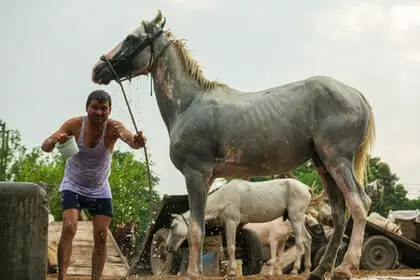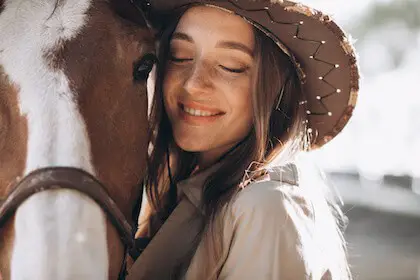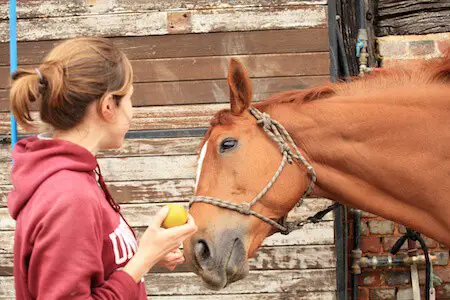The purpose of groundwork exercises for horses is to help strengthen muscles, increase coordination and balance, and establish the bond between horse and human.
Training the horse will make it obey your commands, however, not all horse training can be carried out while sitting in a saddle.
Groundwork can be done in many different ways: grooming, leading around on a halter or lead rope, tying to rails or posts for short periods of time (to teach that they cannot wander off), long longeing sessions where the rider hangs loosely from the saddle as she follows behind her horse as he walks around in circles at a trot or pace.
These are just some examples; there are many more types of groundwork workouts.
Groundwork for Horses – What is it?
Groundwork is a crucial part of horse training, and it gives young horses an understanding of their body as well as teaching them to focus on cues given by riders.
Groundwork is an equine training technique that uses the ground as a tool to simulate various surface types, such as dirt, sand, or water. Known as “barefoot” or “natural” horsemanship, this type of groundwork provides a more natural and comfortable learning environment for young horses.
There are many exercises that can be done in groundwork, but the most important ones are walk-on-a-line, backing up, turn on forehand or hindquarters (or both), and longeing.
These four exercises will help build muscle memory for when they’re riding and will make groundwork more enjoyable for both horse and rider.

The best time to start groundwork with your horse is before he/she has been ridden at all. You’ll want to introduce him/her to things like getting
Working on your horse while on the ground is necessary. Some people do perceive groundwork as boring. Likewise, some individuals who have mastered the basic horse riding skills may feel that their horses do not need groundwork. Many people have the idea that horses are for riding. So, spending time on the ground with a horse does not count.
Groundwork is an essential aspect of horse training and it helps to build the foundation for a well-behaved and confident horse. You can start groundwork with a that is just a year-old horse. During this early age, you can easily rid a horse of bad behaviors. A well-mannered horse will be a good companion for your rides.
Why You Need Groundwork for Your Horse
Groundwork is an essential aspect of horse care and management. It’s the foundation for all other aspects of horse care such as feeding, grooming, tack cleaning and repair, hoof trimming, and veterinary care. Without groundwork to establish a strong bond with your horse and create a safe environment for them to thrive in you’re missing out on an important part of their well-being that will affect their health and happiness.
Groundwork also helps improve physical fitness by increasing lung capacity which can reduce the risk of lung disease later in life. If you want your horse to live a long happy life it’s important to provide them with groundwork so they’ll be able to enjoy everything else there is about owning one.
Many people utilize groundwork to prepare horses to accept riders. Though some still “ride a buck out,” the old method of breaking a horse has waned. The findings of the functioning of a horse’s brain led to the development of new training styles. Besides, amateur horse owners can now learn safer approaches of training a horse to accept a rider from online horse training videos. There are other benefits of the groundwork for both the rider and the horse.
Horse Training Groundwork Basics
Groundwork is the first stage of all horse training processes.
Groundwork encompasses all of the exercises that are done on foot as opposed to on a horse. This type of work includes teaching your horse how to stand patiently, how to lead it around by the halter or rope, and how to groom its coat.

Horses learn the basics of riding during the groundwork sessions. Horses that are yet to be ridden are trained for the breaking process while the trainer is on the ground. Trainers saddle-break horses, add weights to their backs, and ground-drive to make them get used to having riders on their backs. Groundwork ensures safer first rides on horses.
Improves Communication
Clear communication is important between a rider and the horse. Like a dance, you have to speak to a horse with your body.
When it comes to training, riding, grooming and feeding, if you want the best results possible, you need to establish an open line of communication with your horse that is both clear and consistent.
As you learn to communicate to a horse with your body, try and control your emotions and energy. Putting them in check will make your body motions clear. Then it will be easy for the horse to read them. As groundwork progresses to saddle work, the horse has to understand the trainer’s commands.
You can quickly learn the differences in the body language of your horse when you work it on the ground. Through groundwork, you can control your horse’s body motions and movement. You will understand its personality and behavior better as you learn the horse’s body language. Groundwork allows you to perceive your horse’s feelings and thoughts.

Unlike when you are in the saddle, you are not likely to focus on the horse’s body language. You may be aware of your surroundings or have other thoughts distracting you. Even when you think about the horse, it may not be possible to watch its body language from your position. As a result, you may not see when the horse flicks its tail or flares its nostrils.
Without clear communication between you and your horse, exciting rides may be a bit far-fetched. Once achieved, good communication will change your relationship with your horse. It will also help you achieve a good riding experience.
Controlling your Horse’s Movement
Groundwork allows a trainer or rider to have better control over a horse’s movement.
Groundwork is an excellent way to train your horse how to stay within boundaries. By training them with groundwork exercises, you can teach your Horse where they should go and what they should do when given commands such as “walk,” “stand” or “turn“.
Horses are powerful animals, and it’s important that you gain control over their movement. To keep your horse in line, use a rope or halter to guide them. You can also find an experienced trainer to help you learn how to effectively handle the animal.
When you practice groundwork, you will have the opportunity to teach your horse to move exactly the way you commanded it. The horse will not only recognize your cues, but it will also respond to them accordingly.
When your horse responds accurately to your signals, you will be more confident to ride it. You know how it moves and the expected responses when you give cues to the horse. Likewise, the groundwork helps your horse to understand your expectations. It allows the horse to get used to you and follow your lead.
With groundwork, horses have better balance and coordination which will help them be more calm in their environment. Groundwork also helps keep the hooves healthier because it protects them from being overworked on hard surfaces.
Improves Bonding With A Horse
Groundwork deepens the connection between riders or trainers and their horses or helps to create one.
Groundwork teaches the horse to move in close contact with its handler. The handler needs to remain calm and focused during this time, as ground work teaches the horses not to react to any distractions that might arise.
Horses enjoy working closely with their handlers, so groundwork is a great way for both parties involved to bond more closely together.

When you practice groundwork, you have to be patient as you train your horse to understand your signals. Working together with your horse to overcome challenges like achieving better communication can improve the bond between both of you.
Your horse watches you closely as you work with it on the ground. Your body language and motion give clues about your behavior and moods.
Groundwork helps to improve the bonding between humans and their horses by giving them an opportunity to spend quality time together without being mounted on top of each other during work sessions.
As the horse becomes familiar with you, a bond will start to develop between you and your horse. It can sense the way you feel even when you are in the saddle. However, you cannot initiate or strengthen the bond sitting on the saddle. It happens during groundwork.
Improves Trust
Groundwork is a crucial step in building trust with your horse. Every time you work on it, you are demonstrating that you have the patience to take the time and care for them as an individual.
As you work your horse on the ground, you can easily detect its reactions to various situations or fearful occurrences.
It’s not difficult to do, but it can be hard for beginners because they are often uncomfortable with the idea of being so close to such a large animal.
Groundwork is about showing respect and understanding by following simple commands from the horse such as “walk on” or “stand still“. By doing this work together, both will feel more comfortable around each other which encourages them to spend more time interacting in safe ways that ultimately lead to trusting one another better.
You will gain the horse’s trust if you help it to overcome such challenges. Also, it will realize that you are not a threat to his safety. Groundwork allows you to prove to your horse that you are for care about it.
Earn Horse’s Respect
Horses can be difficult to control because they are so large. Groundwork is a great way to show your horse that you are the boss and they should listen to you. It’s also an excellent way to build trust between yourself and your horse.
Groundwork forces horses to follow the lead of their trainers or riders. Horses can easily overpower humans. However, respect is necessary if you want to achieve excellent results training a horse. Despite the bond you share with your horse, you have to set boundaries. Be patient and firm while teaching your horse to listen and obey your commands.
Through groundwork, you can train a horse to respect you. Start by teaching it to understand your cues and respond accordingly to them. If your horse respects you, it will not push you over, walk ahead of you, or step on your feet. Whether you are on the ground or in the saddle, the horse should know that you are the leader.
Teaches your Horse about Safety
Groundwork is an excellent way to teach your horse about safety. It helps them learn basic skills, such as what they should do when encountering a potentially dangerous situation. Groundwork can also help increase their confidence and create a more trusting relationship with their human partner.
You may not be able to know what might scare your horse and unable to predict what can evoke fear in it. The presence of anything terrifying can put you in danger. A horse may throw you off as it bucks or tries to escape in a panic. You can help your horse to overcome fears and improve safety by desensitizing it through groundwork.

While on the ground, introduce different objects, actions, or sounds to the horse. Then watch its reaction to them. The horse’s responses will help you determine the things that scare it. Help your horse to understand that those seemingly terrifying objects are harmless.
In a controlled environment, you can introduce other common occurrences that can trigger fear in a horse. Umbrellas, balloons, flapping coats, crackling tarps, waving flags, and dragging ropes may scare a horse.
Such training will prepare your horse for future exposure to those stimuli. Your horse is likely to have minimal or no reaction to the triggers then. Also, vocal commands are vital to practicing safety measures. Teach your horse to understand such orders. Let it learn to stop when equipment attached to its body becomes loose. Preventive training can save the lives of both riders and horses.
Opportunity for Exercise
Groundwork is a great way to exercise your horse while also improving their mental well-being and physical health.
Through groundwork, a trainer can stimulate a horse’s brain. Such an action helps to improve the problem-solving abilities of the horse. Consequently, your horse will respond better to training.
It’s best to start with some basic exercises, such as walking in circles and backing up, before progressing to more complicated maneuvers like jumping over obstacles or galloping. This way, you’ll have enough time to get used to your horse while still being able to go through a few different movements.
Groundwork exercises can lower the level of a horse’s alertness, which helps to improve safety. It can also be done anywhere there’s enough space – even in a backyard.
It is important to make sure that there are no objects around that could harm both you and your animal if they were accidentally knocked into them during an exercise session.
Teaches your Horse Manners
As a horse owner, you know how important it is to have your horse learn manners. So if your horse likes to kick the stall door, bite at you when you come near, or rear up on its hind legs – then these are signs your horse needs better manners.

Groundwork with horses improves their behavior through exercises of trust, patience and understanding.
No one wants to have a pushy horse. Groundwork is a simple yet effective way to teach your horse manners around humans and other animals, as well as how to balance themselves.
You can train your horse to stand in cross-ties and give its feet willingly for hoof maintenance. Or even learn to drop its head for haltering. Use the groundwork to train your horse to be respectful. Besides, handling your horse will be easier and safer when it is well-mannered.
The process teaches horses who are uncooperative, reactive, or aggressive to develop more appropriate behaviors through corrective training techniques like pressure-release exercises and desensitization practices that help them associate good things with people rather than bad ones.
Final Thoughts
Groundwork leads to great riding. With more friendly methods, you can connect with your horse and establish leadership. Beginners should seek the assistance of professionals in training their horses.
There are a lot of resources available on groundwork for beginners. Books, videos and DVDs are available.
Groundwork exercises for young horses are designed to help the horse’s muscles and joints become strong. Your goal is to have a horse that can carry an adult rider with ease, so start now by teaching your horse how to walk on a lead rope without pulling back.
It’s also important that you teach your new foal or yearling not to bite at humans who try and touch them around the head or neck areas because this could result in injury. These types of movements will ensure that when your child gets out there riding their first pony, they’ll be able to do it confidently knowing their animal has been well-trained from the beginning.

